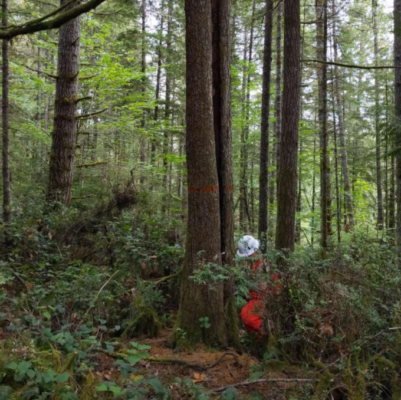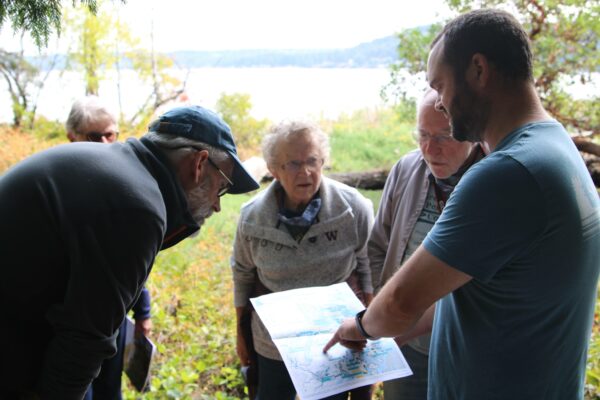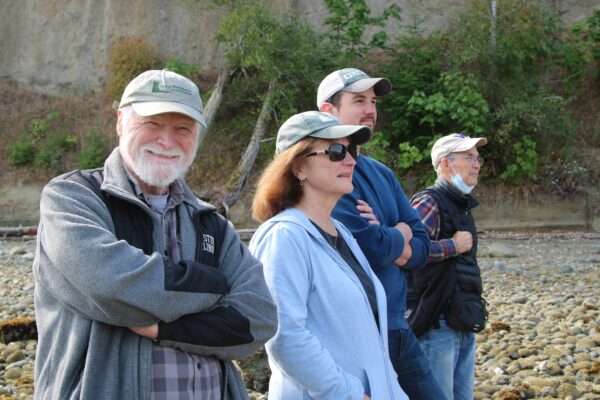1. Build Habitat Piles
Everybody needs a place to live, and habitat piles are like high-rise apartments for the forest! Especially in second-growth forests where there’s not always a lot of places to live, habitat piles can be essential. Squirrels, chipmunks, toads, newts, songbirds, and more will all move in to one these – and they’ll thrive!
Every habitat pile has a 10’x10’ base, and rises up 6’. The base is made out of big logs, the middle is made from progressively smaller logs and branches, and then at the top it’s crowned with brush and leaves and branches. These piles imitate the heaps of wood and other materials found in mature forests. They’re great biodiversity boosters!

2. Girdle Trees
The thing about second-growth forests is that their trees are often all the same age! You might not notice it when you’re hiking through, but for animals that depend on dead wood, this can be a real problem.
For instance, lots of birds will only build nests in cavities dug out of standing dead trees, or “snags.” If every tree in a forest is only about 40 years old – it might be a while before any snags form naturally.
Luckily a snag is easy to make, when you’ve been properly trained, with a technique called “girdling.” On the trunk of the tree, the only living vascular tissue is in the outer layers of bark. Cut away a ring of bark from the trunk, and the tree dies. It’s a tough break for the individual, but the forest – and especially those cavity-nesters – will thank you.

3. Remove Invasive Species
We’ve all seen the Himalayan Blackberry, English Ivy, and the Holly that have thrived in the Northwest ever since being introduced. These plants take up valuable space and nutrients, shade out young saplings, and burden the trees they latch onto. They put a lot of stress on a forest ecosystem, and disrupt the healthy cycles of sunlight, nutrients, and water through our landscapes.
When you remove these species, the forest will start to flourish again. To take care of holly and blackberry, you’ll only need some clippers and the thickest pair of gloves you can find to protect against thorns and prickly leaves. Ivy can be pulled right out of the ground, but if you see it growing up a tree, then create a survival ring instead! Don’t ever try pulling ivy off a tree, though – you might dislodge something heavy up above.

4. Plant Native Species – and Assist With Migration
Once you’ve removed invasive species, you may find yourself with some open space! Don’t just leave it open, though, because nature abhors a vacuum. If you don’t plant something there, invasive species might just come right back and take up the same space.
Instead, plant native species as much as you can to bolster our native ecosystems. It’s good to do some research to try and find out which plants are suited to the landscape you’ll be working in. At Great Peninsula Conservancy, our stewardship team works hard to match the right plants to the preserves that need them. They even help to assist with plant migration – by selecting native species from nurseries further south, GPC hopes to introduce new traits that will help our ecosystems continue to thrive even as the climate changes.

5. Advocate for your environment
Lawmakers at the city, county, and state level are always considering different laws and policies that will impact our forests and their resilience. Keep track of what your representatives are working on, and advocate for what you believe is right!
Policies that help forests can include things like funding for environmental restoration, protecting pieces of land from harvest or development, encouraging responsible land use practices, and more. Get connected with advocacy organizations and see what you can do to help!

6. Participate in events!
GPC always has events coming up where we invite the public onto our lands to participate in our restoration projects. That can mean removing invasive species or planting natives or building habitat piles, and more!
We’re not the only ones working on these projects. Some other local groups include the Friends of Miller Bay, the North Kitsap Heritage Park Stewards, the Clear Creek Task Force, and more. Participating in these stewardship events makes a huge difference.
